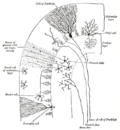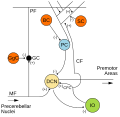Basket cell
Basket cells are a type of interneuron found in the cerebral cortex and hippocampus, regions of the brain that play key roles in memory, attention, perception, and consciousness. Named for their basket-like appearance, these cells are critical for the regulation of neuronal activity.
Function[edit]
Basket cells are inhibitory interneurons, meaning they help to regulate the activity of other neurons. They do this by releasing inhibitory neurotransmitters, such as gamma-aminobutyric acid (GABA), which decrease the likelihood that the receiving neuron will fire an action potential. This inhibitory function is critical for maintaining the balance of excitation and inhibition in the brain, which is necessary for normal brain function.
Structure[edit]
Basket cells are characterized by their dense, basket-like network of axons that envelop the cell bodies of other neurons. This allows them to influence the activity of these neurons by releasing inhibitory neurotransmitters directly onto their cell bodies.
Clinical significance[edit]
Abnormalities in basket cells have been implicated in a number of neurological and psychiatric disorders, including schizophrenia, autism, and epilepsy. For example, post-mortem studies of individuals with schizophrenia have found a decrease in the number of basket cells in certain regions of the brain. This suggests that these cells may play a role in the pathophysiology of this disorder.
See also[edit]

This article is a neuroscience stub. You can help WikiMD by expanding it!
Basket_cell[edit]
-
Gray706
-
Cerebellum - biel - very high mag
-
Diagram of the Microanatomy of Human Cerebellar Cortex
-
Cerebellum - biel - high mag
Ad. Transform your life with W8MD's Budget GLP-1 injections from $75


W8MD offers a medical weight loss program to lose weight in Philadelphia. Our physician-supervised medical weight loss provides:
- Weight loss injections in NYC (generic and brand names):
- Zepbound / Mounjaro, Wegovy / Ozempic, Saxenda
- Most insurances accepted or discounted self-pay rates. We will obtain insurance prior authorizations if needed.
- Generic GLP1 weight loss injections from $75 for the starting dose.
- Also offer prescription weight loss medications including Phentermine, Qsymia, Diethylpropion, Contrave etc.
NYC weight loss doctor appointmentsNYC weight loss doctor appointments
Start your NYC weight loss journey today at our NYC medical weight loss and Philadelphia medical weight loss clinics.
- Call 718-946-5500 to lose weight in NYC or for medical weight loss in Philadelphia 215-676-2334.
- Tags:NYC medical weight loss, Philadelphia lose weight Zepbound NYC, Budget GLP1 weight loss injections, Wegovy Philadelphia, Wegovy NYC, Philadelphia medical weight loss, Brookly weight loss and Wegovy NYC
|
WikiMD's Wellness Encyclopedia |
| Let Food Be Thy Medicine Medicine Thy Food - Hippocrates |
Medical Disclaimer: WikiMD is not a substitute for professional medical advice. The information on WikiMD is provided as an information resource only, may be incorrect, outdated or misleading, and is not to be used or relied on for any diagnostic or treatment purposes. Please consult your health care provider before making any healthcare decisions or for guidance about a specific medical condition. WikiMD expressly disclaims responsibility, and shall have no liability, for any damages, loss, injury, or liability whatsoever suffered as a result of your reliance on the information contained in this site. By visiting this site you agree to the foregoing terms and conditions, which may from time to time be changed or supplemented by WikiMD. If you do not agree to the foregoing terms and conditions, you should not enter or use this site. See full disclaimer.
Credits:Most images are courtesy of Wikimedia commons, and templates, categories Wikipedia, licensed under CC BY SA or similar.
Translate this page: - East Asian
中文,
日本,
한국어,
South Asian
हिन्दी,
தமிழ்,
తెలుగు,
Urdu,
ಕನ್ನಡ,
Southeast Asian
Indonesian,
Vietnamese,
Thai,
မြန်မာဘာသာ,
বাংলা
European
español,
Deutsch,
français,
Greek,
português do Brasil,
polski,
română,
русский,
Nederlands,
norsk,
svenska,
suomi,
Italian
Middle Eastern & African
عربى,
Turkish,
Persian,
Hebrew,
Afrikaans,
isiZulu,
Kiswahili,
Other
Bulgarian,
Hungarian,
Czech,
Swedish,
മലയാളം,
मराठी,
ਪੰਜਾਬੀ,
ગુજરાતી,
Portuguese,
Ukrainian



